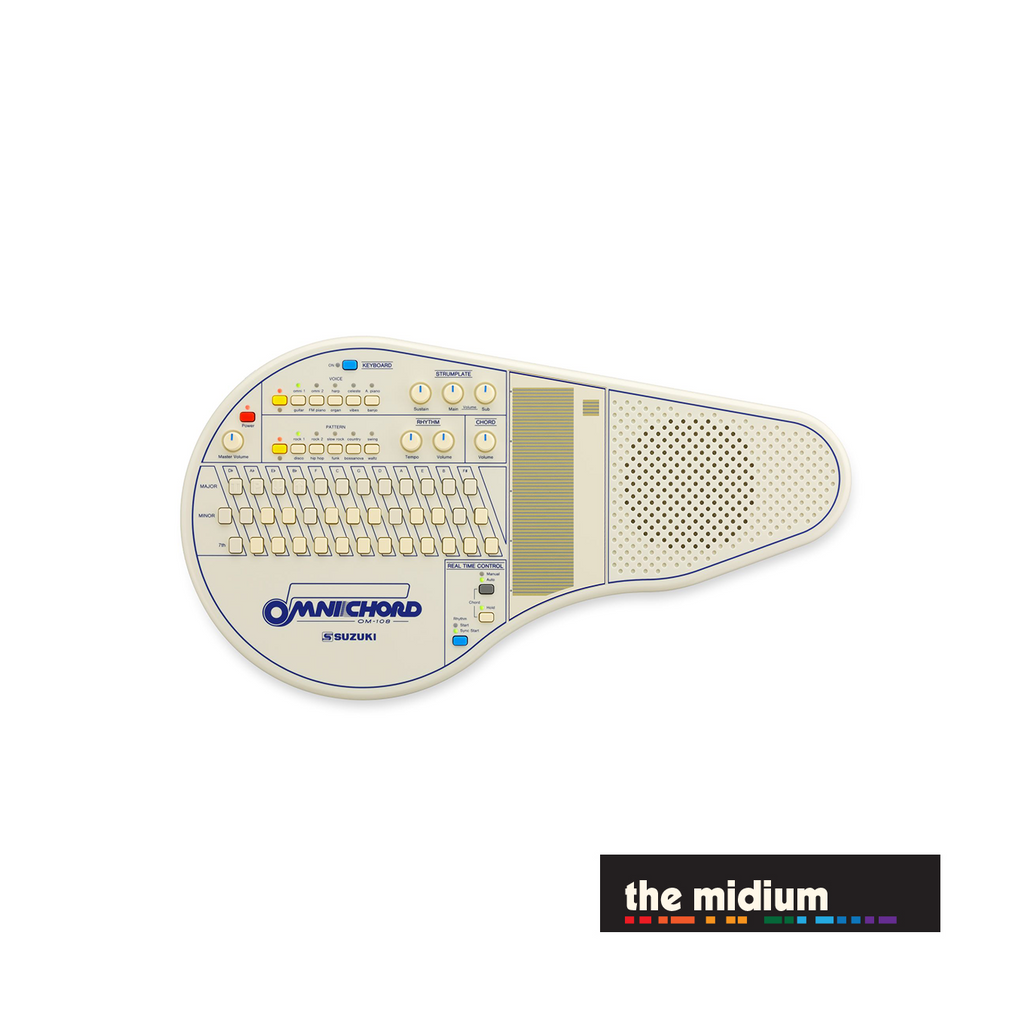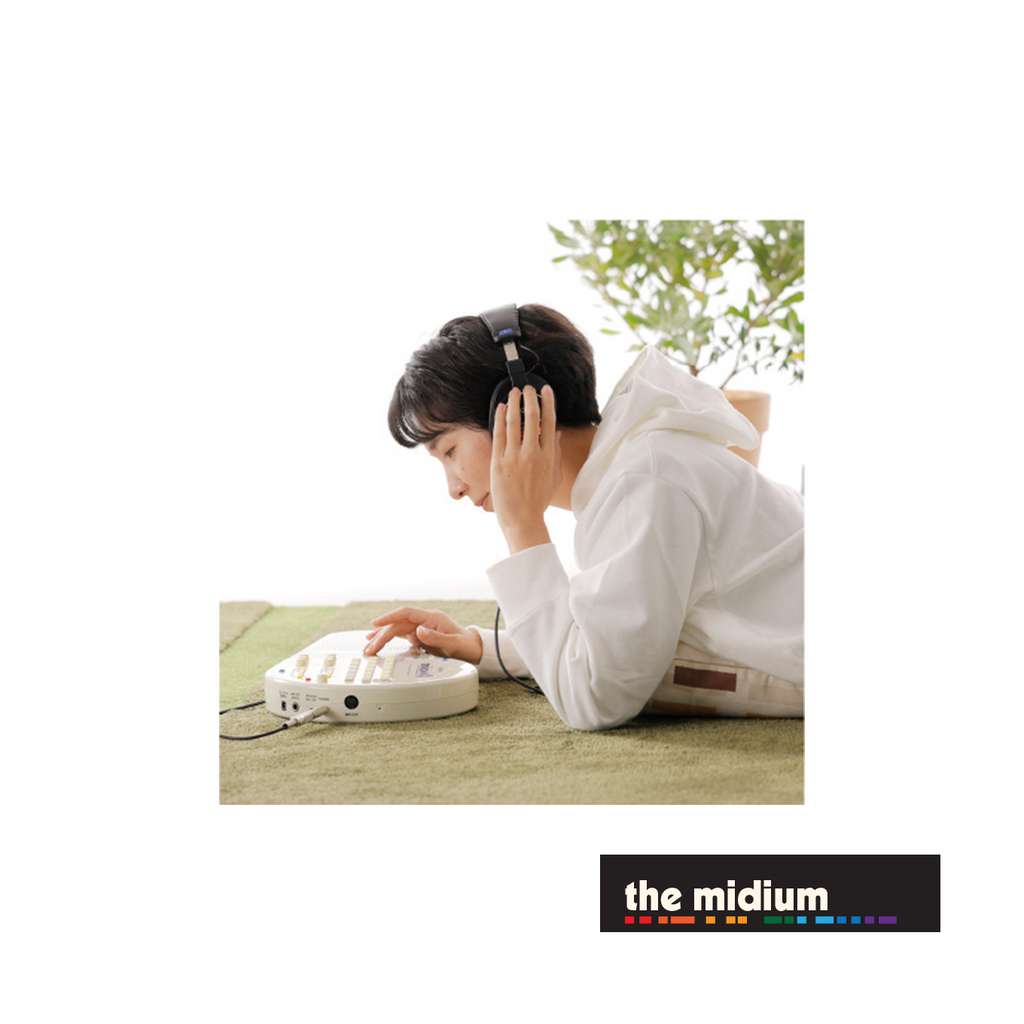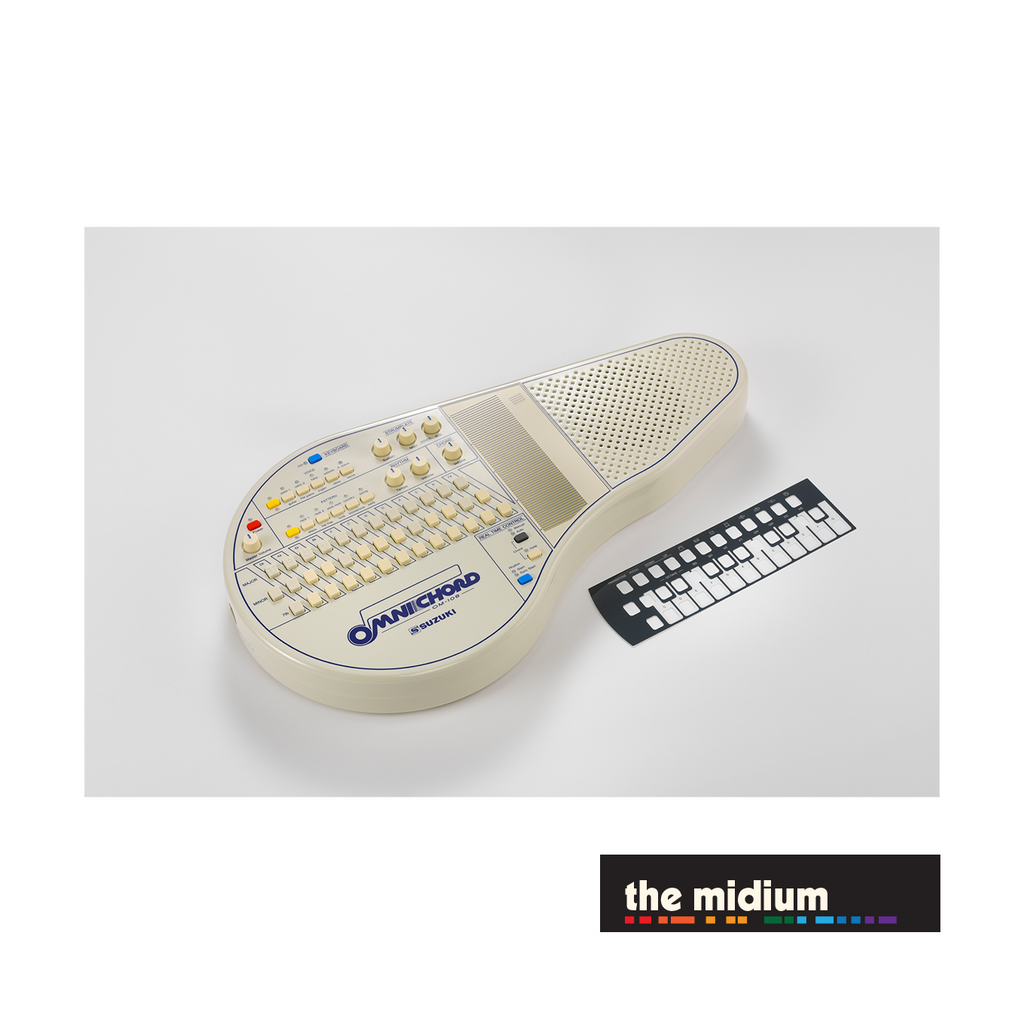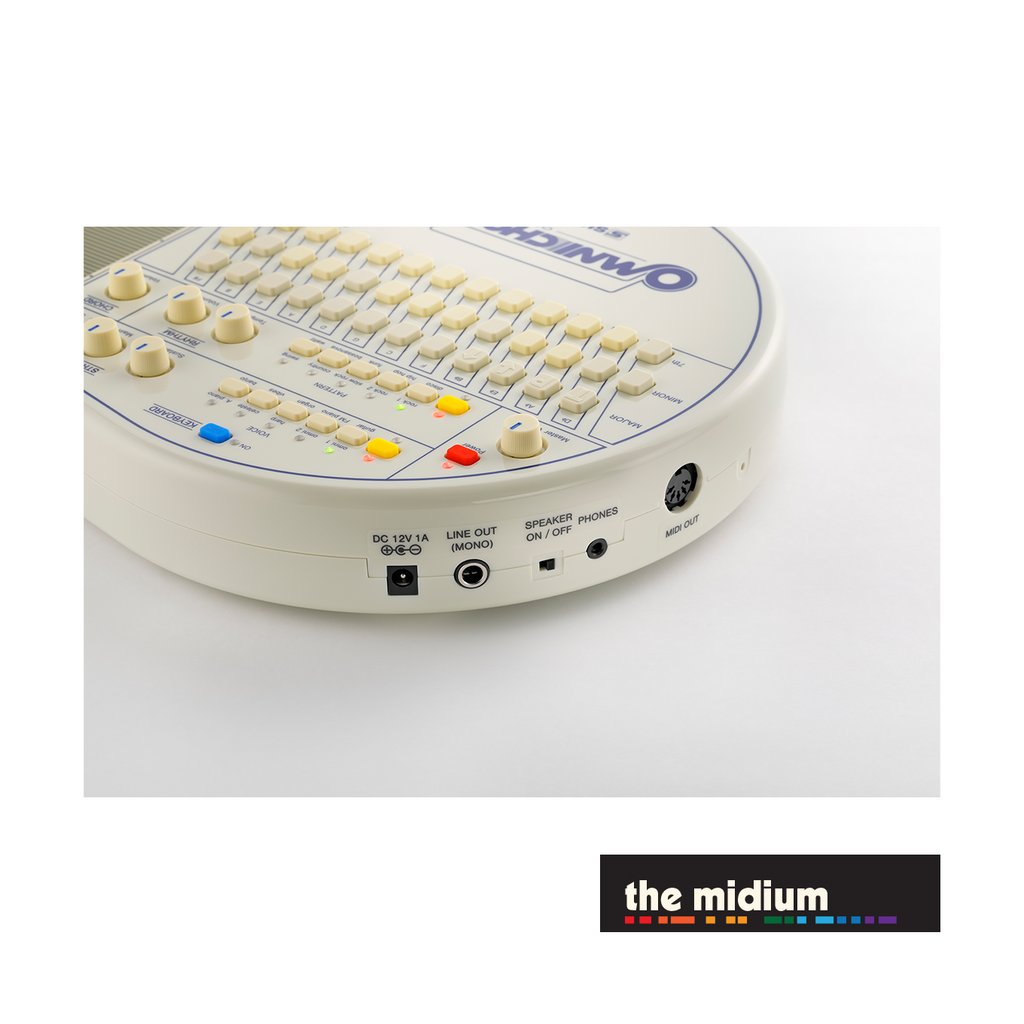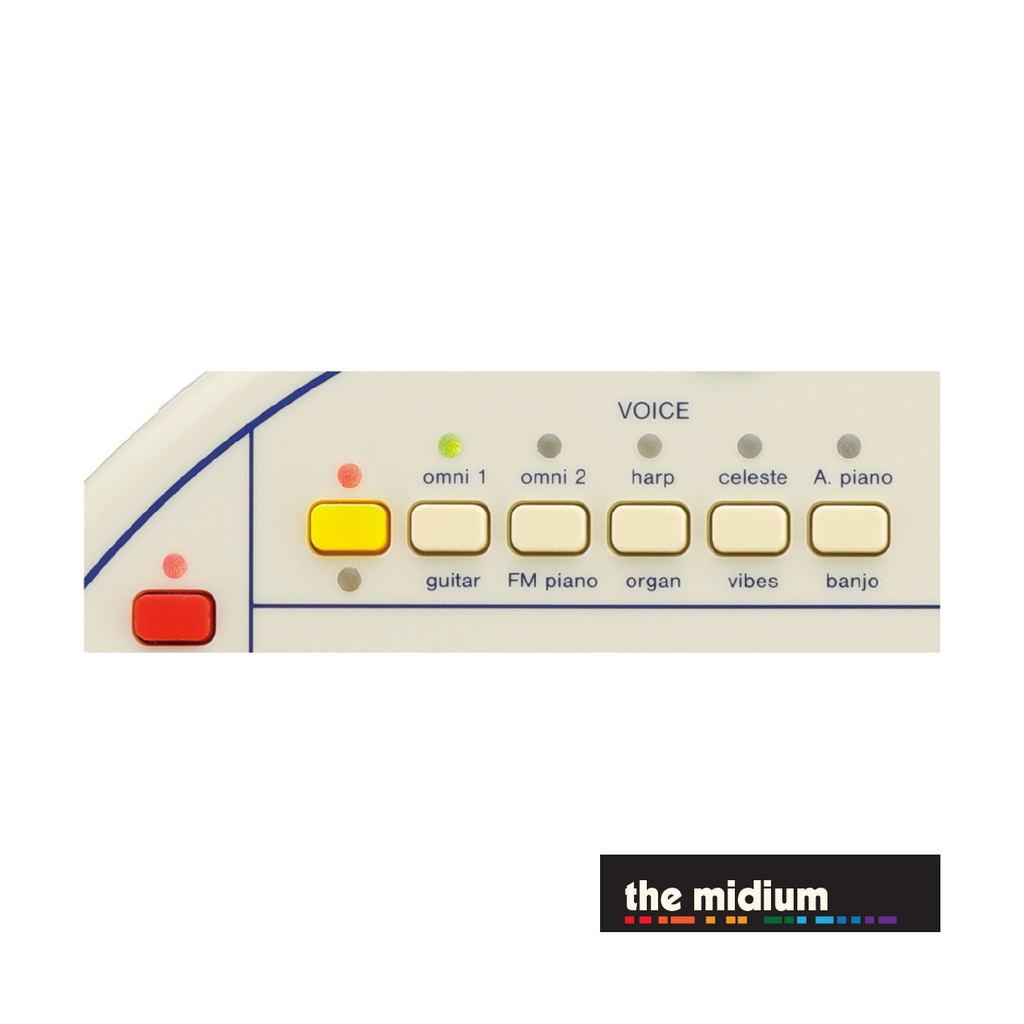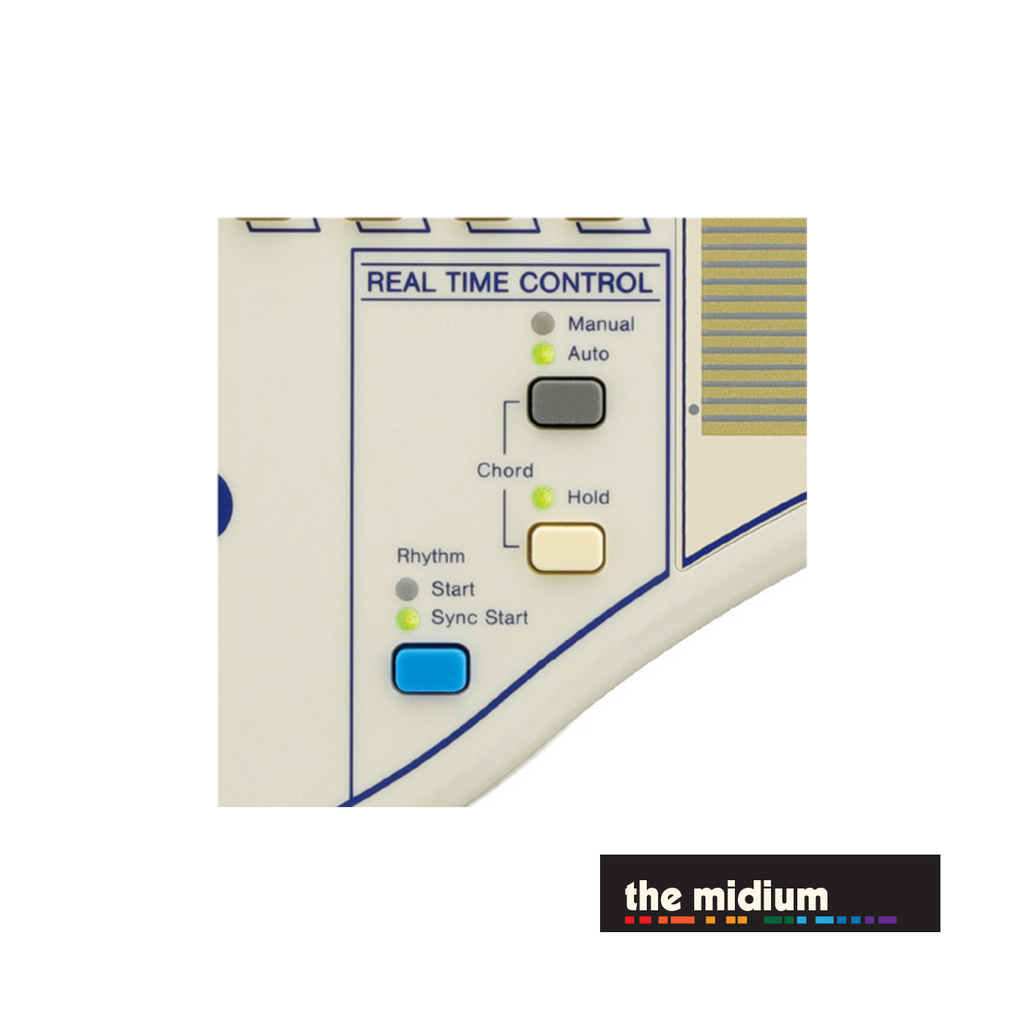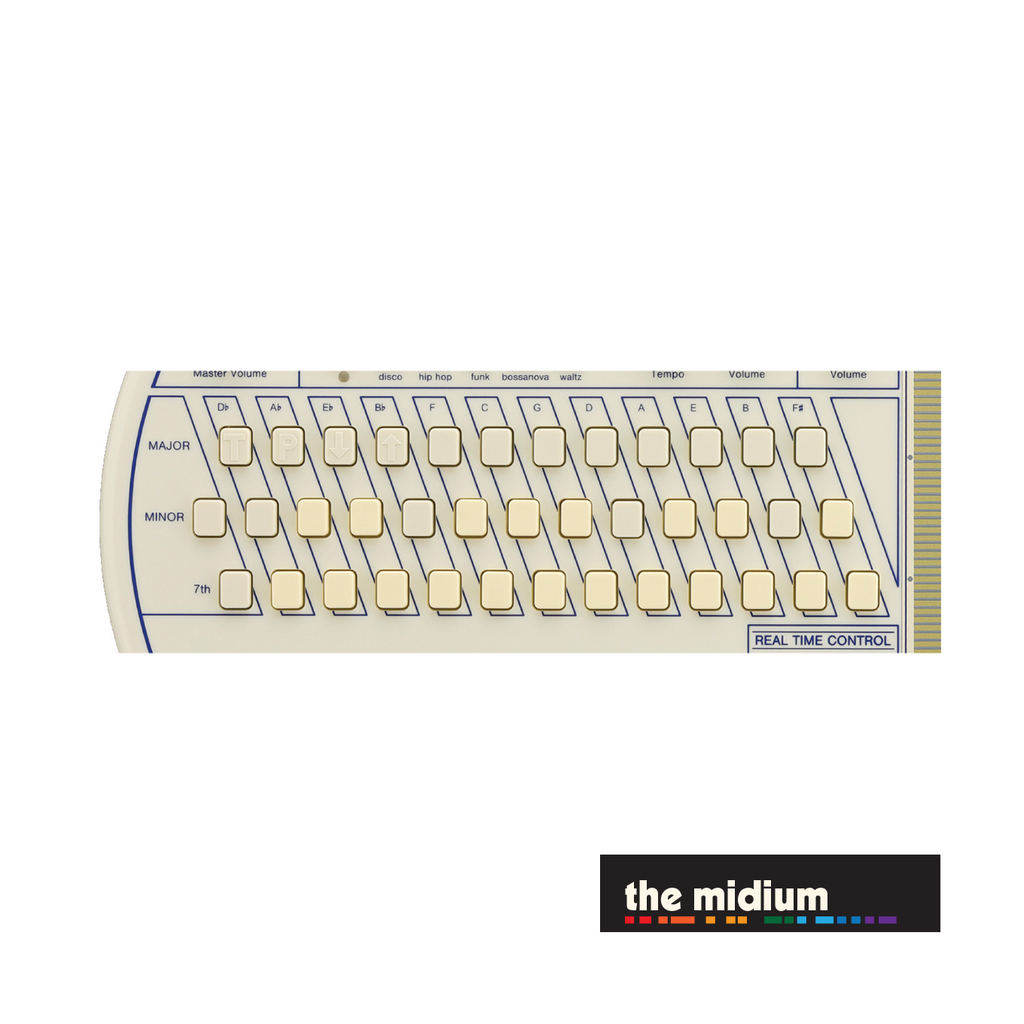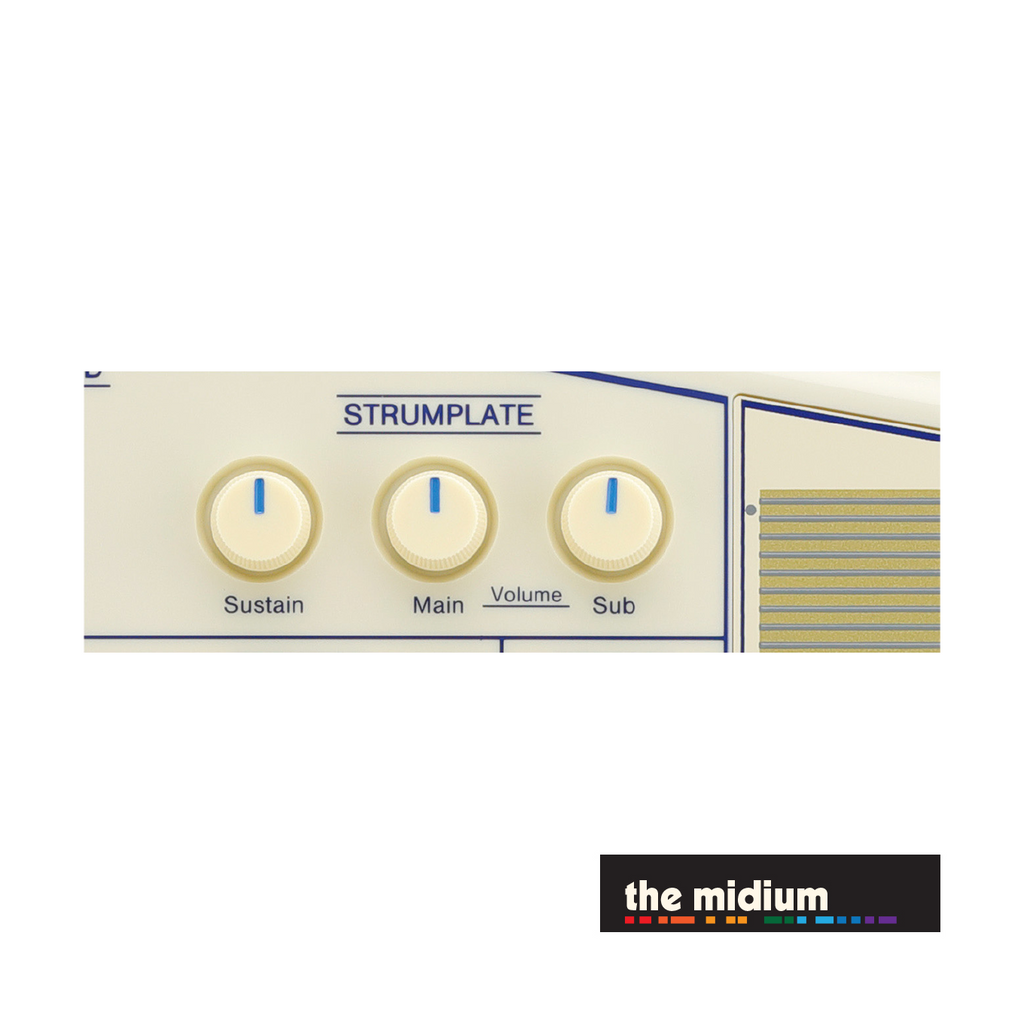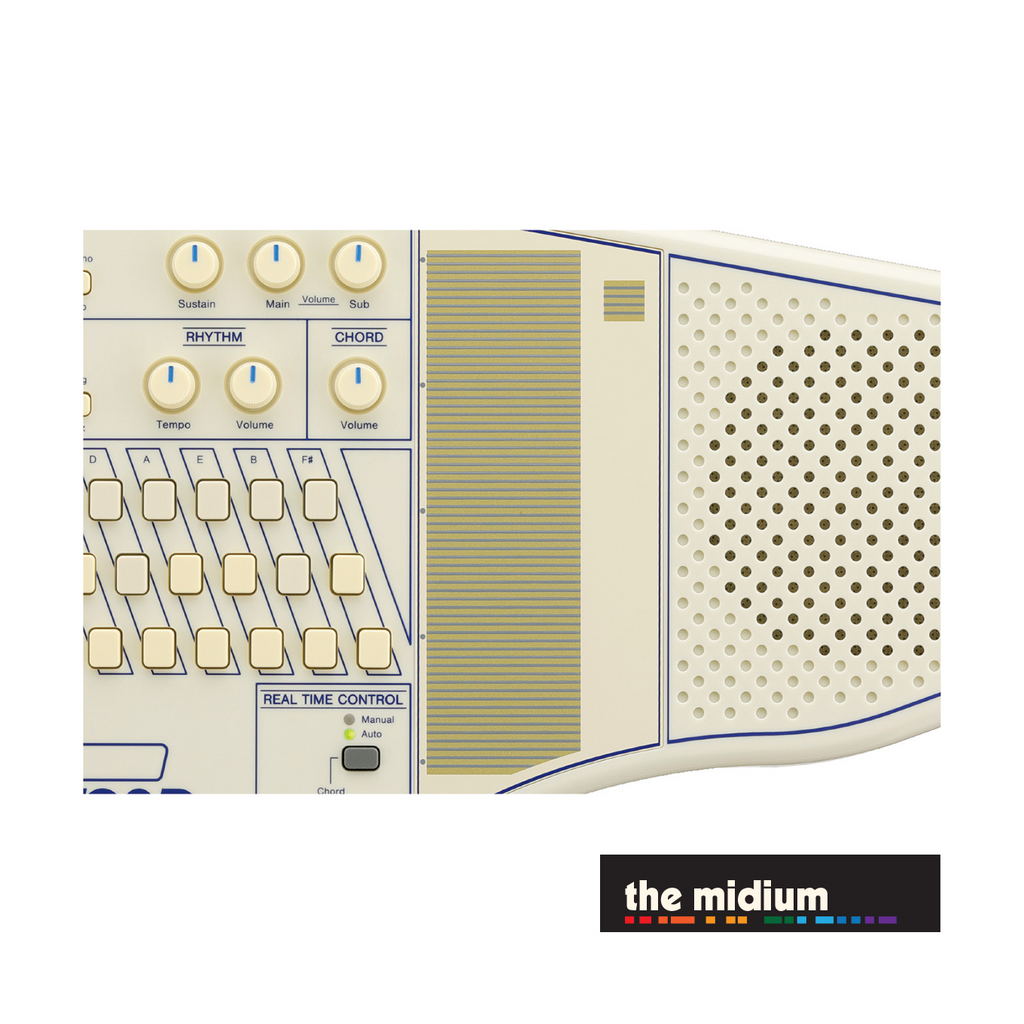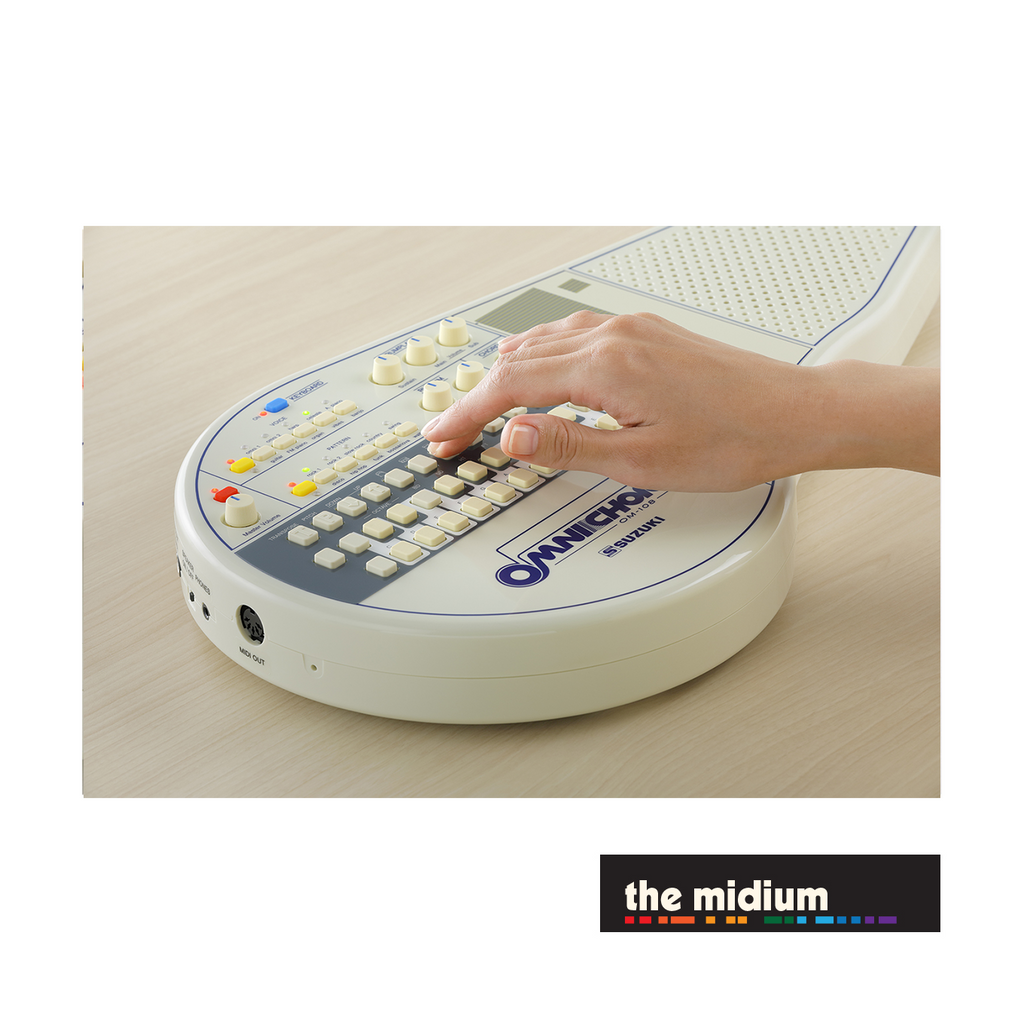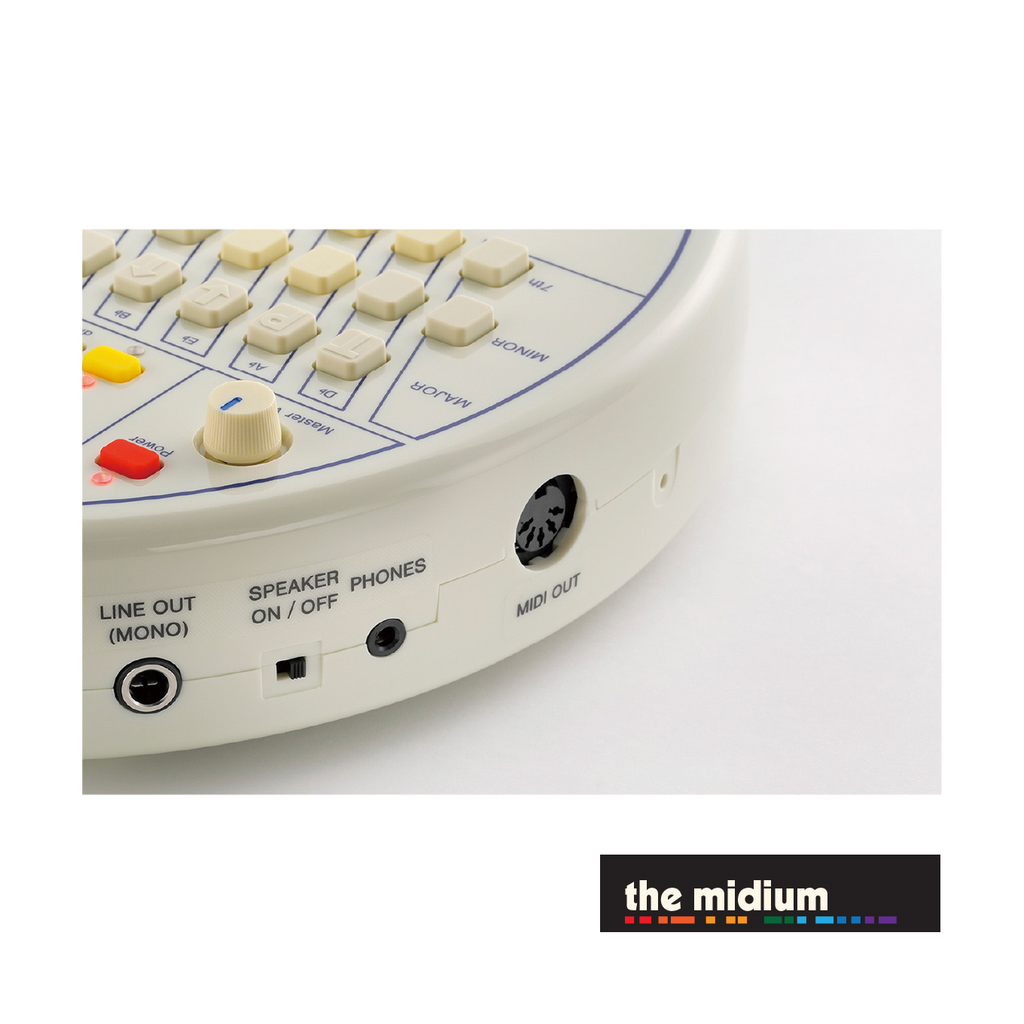Suzuki's description of the Suzuki Omnichord OM-108
WHAT IS OMNICHORD?
FORM AND SIZE.
The shape of the new Omnichord is based on the still very popular previous models of the OM-27, OM-36 and OM-84, with the curved shape on the left side of the body. In addition, the overall dimensions are one size smaller than the OM-27, making it a compact size that is easier to carry around. Regarding the OM-27, OM-36 and OM-84, which became the basis for the shape of the new Omnichord, we will introduce a little more information along with the history of Omnichord.
[New model] Size: 460×250 mm
[OM-27] Size: 520 x 280 mm
The Omnichord is characterized by its streamlined body. According to 'Omnichord Communication Paper No. 1' published in Japan in 1982, this shape seems to express the thinking of a more futuristic musical instrument, with the shape as a motif, symbolizing the form of an overflowing happy tear. The body colour of the OM-27 was brown, red, and ivory. *The image is the colour lineup of the OM-27.
ABOUT SPECIFICATIONS.
The Omnichord is the world's first electronic musical instrument with auto-accompaniment, equipped with an auto-harp sensor. Various functions were added to the successor models as technology progressed, but the style of playing by touching the chord buttons and metal strum plates lined up in the centre and being lightweight and easy to carry anywhere was already established from around this time. With the idea that "There's no dream of a fully automatic electronic instrument! Let's just sing the melody!" As a keyword, the OM-27 had a total of 27 chords of Eb, Bb, F, C, G, D, A, E, B Major, Minor, Seventh and the tone is one harp pattern. With the OM-36/84, major seventh and augment had been added, expanding the total to 84 chords. In addition, the OM-84 had two patterns of harp sounds, and a memory function that had enabled the player to record chords. This function was groundbreaking at the time, allowing you to play more freely. (From “Omnichord Communication Paper No.1” published in 1982.)
INTRODUCING THE SOUNDS OF OMNICHORD.
Here are just a few of the tones installed on to the new Omnichord. Please listen to the classic sounds that were installed on to the past models and the sounds that will be revived more beautifully.
Original Voice 00:00~
The strum plate sound and tone of the OM-27, OM36, and OM84 was produced by analog circuits. The new Omnichord also uses some analog technology to bring this original sound back to life!
This sound, which is unique to analog circuits, should be something that makes you feel, 'This is the Omnichord.'
Harp 0:14~
The beautiful tone that was installed on to the original OM-250M and OM-300 was resurrected with even higher sound quality on to the new Omnichord.
Celeste 0:22~
This is also a beautiful tone originally installed on to the OM-250 and OM-300. This is also resurrected with even higher sound quality.
On the New Omnichord, by layering two sounds on to the strumplate, it makes it possible to add more expression to the sound.
0:00~ Original Voice + OM-84 Vibrato Voice
The OM-84 had two electric harp sounds that could be layered. The new Omnichord perfectly replicates this same feature of the OM-84.
0:16~ FM piano + Mellow Synth. Pad
A mellow synth pad is layered on to a glittering electric piano with an FM tone generator.
0:24~ Acoustic Piano + Synth/Strings
Synth strings are layered on tothe sound of an acoustic piano.
0:34~ 0:49 Original Voice + Synth/Strings
Synth/strings are layered on to anelectric harp tone.
We will introduce a little about the chords. In the reproduction model, "sus4 / add9" this will be a newly added. Please listen to the performance using these chord variations.
The model number of the reproduced Omnichord has been decided as OM-108. The model number not only differentiates the product from previous models, but also indicates its features and functions. In the table below, you can view the model number and specifications of the older models.
| Model | Year of release | Strum plate | Chord |
| OM-27 | 1981 | 4 octaves, Tone/Harp |
27 chords |
| OM-36, OM-84 | 1984 |
4 octaves Tone/OM-36(Harp), OM-84(Harp x 2) |
84 chords |
| OM-100, OM-200M |
1989 |
4 octaves Tone/ Guitar, Piano, Banjo, Jazz Organ, Flute, Organ, Chime, Brass, Vibraphone, Synth. |
84 chords |
| OM-150, OM-250M |
1993 |
4 octaves Tone/ Omnichord, Guitar Harp, Banjo, Strings, Piano, Organ, Celeste, Marimba, Steel drum |
84 chords |
| OM-300 | 1996 |
4 octaves Tone/ Omnichord, Guitar, Harp, Banjo, Strings, Piano, Organ, Celeste, Marimba, Steel drum |
84 chords |
| QC-1 | 1999 | 4 octaves / 100GM tone |
36 soft touch buttons, 84 chords |
This time, we will introduce three rhythm patterns that will be installed in the New Omnichord OM-108. Playing along with preset rhythm patterns is one of the joys of the Omnichord. In addition, the OM-108's rhythm patterns have been updated to include a more contemporary selection than it's predecessors. Please listen to the performance that combines the tones and chords introduced so far!
Rock1/ 0:00~
An oldies rock rhythm that has been installed in many previous Omnichords.
Hip Hop/ 0:17~
Equipped with trap beat for the first time in Omnichord.
Funk/0:43~1:11
A disco funk pattern is also installed for the first time as an Omnichord.
The new Omnichord will include several more beautiful tones that were installed on to the previous Omnichords. Stay tuned for more news!
HISTORY OF THE OMNICHORD.
Originally development started with a request from an overseas sales company to make an electronic musical instrument like an auto-harp. It started with the electronic musical instrument 'PC-27' and the first Omnichord 'OM-27' was born in 1981 with improvements to the interface and functions. Since then, as technology has advanced, we have created numerous models through trial and error in adding more chords, timbres, and designs.OM-27 RELEASED IN 1981.
PC-27
An electronic musical instrument that was the predecessor of the OM-27
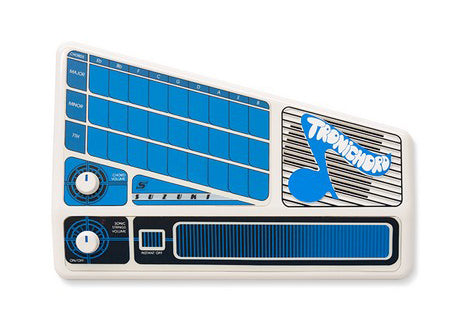
[Strumplate] 4 octave tone/harp
[Chord] 45 chord
[Body color] Ivory
OM-27
Released in 1981
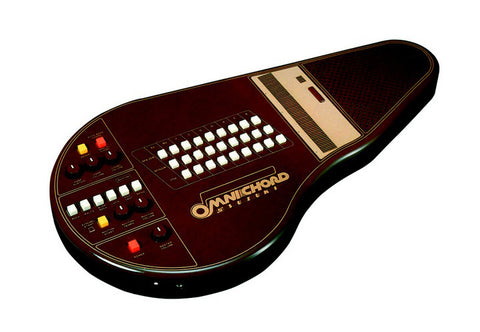
[Strumplate] 4 octave tone / harp
[Chord] 27 chords
[Rhythm] Rock, Waltz, Slow Rock, Latin Foxtrot, Swing
[Body Color] Brown, Ivory, Red
OM-36 OM-84
1984 Simultaneous release of two models

[Strumplate] 4 octave tones / OM-36 (harp) OM-84 (harp x 2)
[Chord] 84 chords
[Rhythm] Rock 1, Rock 2, Disco, Latin, Country, March, Tango, Blues, Swing, Waltz
[Body color] OM-36 (beige) OM-84 (gray, ivory)
[Remarks] Only OM-84 is equipped with functions such as keyboard, transpose, and chord memory.
*The image is OM-84
OM-100 OM-200M
In 1989 2 models released simultaneously
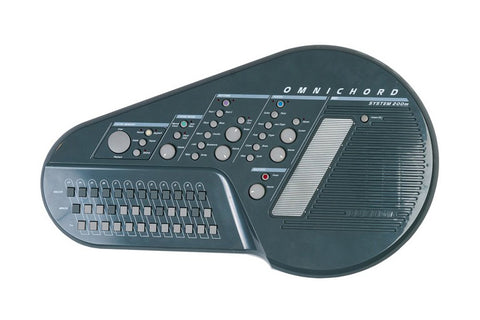
[Strumplate] 4 octaves Tone/Guitar, Piano, Banjo, Jazz Organ, Flute, Organ, Chime, Brass, Vibe, Synth
[Chord] OM-100 (36 chords) OM-200M (84 chords)
[Rhythm] Rock 1, Rock 2, Disco, Blues, March, Country, Latin, Bossa Nova, Swing, Waltz [Body color] OM-100 (beige) OM-200M (gray)
[Remarks] OM-200M only has functions such as keyboard, transpose, MIDI OUT, and chord memory.
*The image is OM-200M
OM-150 OM-250M
In 1993 Simultaneous release of two models
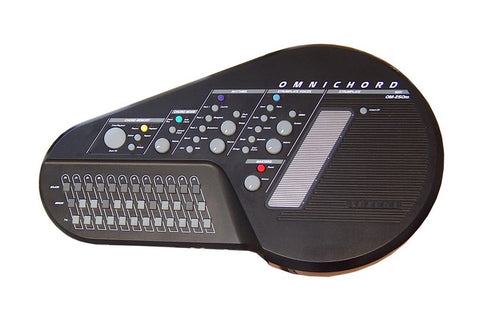
[Strumplate] 4 octaves Tone / Omnichord, Guitar, Harp, Banjo, Strings, Piano, Organ,
Bossa Nova, Celesta, Marimba, Steel Drum, Bossa Nova
[Chord] 84 chords
[Rhythm] Rock 1, Rock 2, Rock 3, March, Jazz, Country, Bluegrass, Samba, Waltz
[Body color] OM-150 (beige) OM-250M (gray)
[Remarks] OM-250M only had functions such as keyboard, transpose, MIDI OUT, and chord memory.
*The image is OM-250M
OM-300
Released in 1996
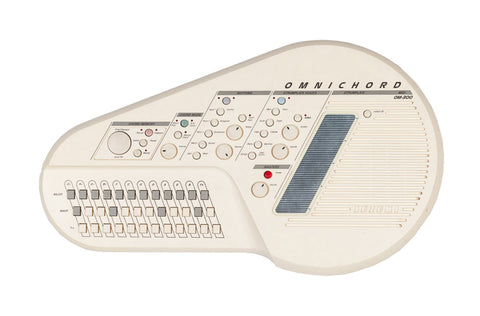
[Strumplate] 4 octaves Tones/Omnichord, Guitar Harp Banjo, Strings, Piano, Organ, Celesta, Marimba, Steel drum
[Chord] 84 chords
[Rhythm] Rock 1, Rock 2, Rock 3, March, Jazz, Country, Bluegrass, Bossa Nova, Samba, Waltz
[Body color] beige
Qchord QC-1
Released in 1999 Digital Song Card Guitar
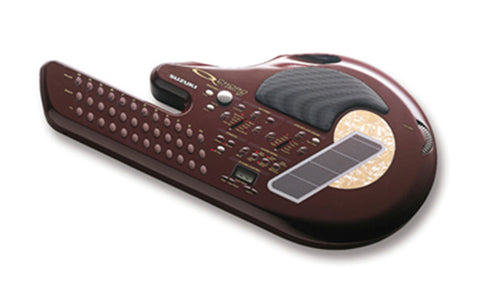
[Strumplate] 4 octaves 100GM tone
[Chord] 36 soft touch buttons, 84 chords
[Rhythm] Bossa Nova Country, Dance, Jazz, New Age, March, Waltz, Ballad, Rock, Blues Shuffle, Bossa Nova
[Remarks] Song data can be played back with song and rhythm cartridges.

